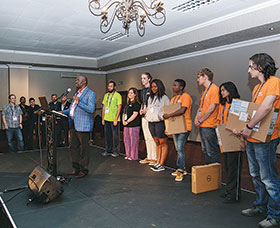Supercomputing students bring home third prize
18 July 2018
Editor's Choice
News

The South African supercomputing team that participated in the International Student Cluster Competition in Frankfurt, Germany, took third place behind China’s Tsinghua University and Nanyang Technological University of Singapore.
The team of six, made up of undergraduate computer science and engineering students from the Universities of the Witwatersrand and Limpopo, was one of 12 teams from around the world that participated in the prestigious challenge from 25 to 27 June 2018.
The students showcased computing systems of their own design, adhering to strict power constraints and seeking to achieve the highest performance across a series of standard high-performance computing benchmarks and applications. South Africa has been participating in the international competition since 2013 and won it in 2013, 2014 and 2016, coming second in 2015 and 2017. It is one of the few teams that consists entirely of undergraduate students, and that sends different students each year.
Before participating, the members of the team received extensive training from the Centre for High Performance Computing (CHPC), an initiative of the Department of Science and Technology and the Council for Scientific and Industrial Research (CSIR).
The CHPC’s Director, Dr Happy Sithole, said that the placing was “a significant achievement for South Africa,” and that the CHPC hopes to increase the number of students who received exposure of this kind in the field of high-performance computing. “In the past six years we have had 36 students performing well on the world stage,” he said.
The South African team was chosen from 10 participating teams at a national student cluster supercomputing competition held in December last year. Team selection for the national competition takes place at the CHPC’s Winter School, which is designed to impart critical knowledge for building a cluster. This includes using Linux systems, the basic software stack of a cluster, and considerations that should be taken into account when choosing hardware. Team selection concludes with an assignment that requires each team to build a prototype cluster in the cloud.
After all their hard work, this year’s team – Meir Rosendorff, Joshua Bruton, Kimessha Paupamah, Katleho Mokoena, Nathan Michlo and Njabulo Sithole – said that they planned to hire bicycles and cycle around Frankfurt “doing touristy things”.
For more information contact Nox Moyake, CHPC, [email protected]
Further reading:
The ‘magic’ of photovoltaic cells
Editor's Choice
Everyone knows that solar generation converts sunlight to electricity, but what comprises a solar panel, and how do they actually work?
Read more...
Analysis of switch-mode power supply: inductor violations
Altron Arrow
Editor's Choice Power Electronics / Power Management
Common switch-mode power supply (SMPS) design errors are discussed, and their appropriate rectification is specified, with details on complications that arise with the power stage design of DC-DC switching regulators.
Read more...
Bridging the gap between MCUs and MPUs
Future Electronics
Editor's Choice AI & ML
The Renesas RA8 series microcontrollers feature Arm Helium technology, which boosts the performance of DSP functions and of AI and machine learning algorithms.
Read more...
Accelerating the commercialisation of the 5G IoT markets
Altron Arrow
Editor's Choice Telecoms, Datacoms, Wireless, IoT
Fibocom unveils Non-Terrestrial Networks (NTN) module MA510-GL, enabling satellite and cellular connectivity to IoT applications.
Read more...
Hardware architectural options for artificial intelligence systems
NuVision Electronics
Editor's Choice AI & ML
With smart sensors creating data at an ever-increasing rate, it is becoming exponentially more difficult to consume and make sense of the data to extract relevant insight. This is providing the impetus behind the rapidly developing field of artificial intelligence.
Read more...
Demystifying quantum
Editor's Choice
Quantum, often called quantum mechanics, deals with the granular and fuzzy nature of the universe, and the physical behaviour of its smallest particles.
Read more...
Service excellence with attention to detail
Deman Manufacturing
Editor's Choice
The vision of industry pioneers Hugo de Bruyn and Charles Hauman led to the birth of Deman Manufacturing, a company that sets new standards for innovation and performance within the industry.
Read more...
What is an RF connector?
Spectrum Concepts
Editor's Choice Interconnection
If you look across the broader electromagnetic spectrum, the selection of the 3 kHz to 300 GHz frequency range for RF signals is a result of a balance between propagation characteristics, data transmission requirements, regulatory allocations, and the compatibility of electronic components and devices.
Read more...
Make your small asset tracker last longer
Altron Arrow
Editor's Choice Power Electronics / Power Management
This design solution reviews a typical asset tracking solution, and shows how the MAX3864x nanopower buck converter family, with its high efficiency and small size, enables longer battery life in small portables.
Read more...
The power of Matter
Editor's Choice Telecoms, Datacoms, Wireless, IoT
Matter offers a reliable, secure, seamless way to interconnect devices from different manufacturers, allowing a new level of interoperability to be enjoyed.
Read more...

